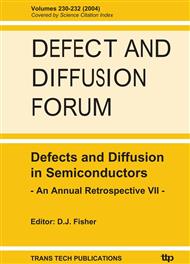p.101
p.111
p.125
p.135
p.149
p.177
p.199
p.221
p.233
Modelling of Staebler-Wronski Effect in Hydrogenated Amorphous Silicon under Moderate and Intense Illumination
Abstract:
A new model is developed for the Staebler-Wronski effect (SWE) in intrinsic a-Si:H. In this model, non-radiative recombination of the photogenerated carriers occurs at a weak bond close to a SiHHSi configuration, which allows a local creation of defect of the SiHD type. This defect can be annihilated by mobile hydrogen atom that has been emitted from an other distant SiHD defect as a result of non-radiative recombination at this defect site. In this study we have considered illumination intensities in the moderate and intense illumination range. In both cases, the proposed model reproduces many experimental features of the SWE known in the literature.
Info:
Periodical:
Pages:
221-232
Citation:
Online since:
November 2004
Authors:
Price:
Сopyright:
© 2004 Trans Tech Publications Ltd. All Rights Reserved
Share:
Citation:


